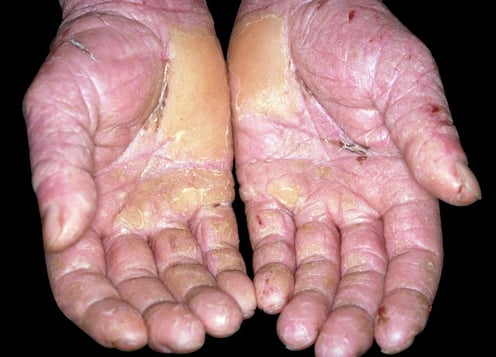Toolbox Talks
CES Hire Toolbox Talk Tuesday: Gloves: Necessity Or Fashion Statement?
Problems And Protection When Working With Cement, Concrete And Plaster
For me, this past weekend with the plunging temperatures, snow and ice, I have absolutely needed to don the thickest and woolliest of gloves and even then, I’ve felt cold. Goalkeepers slip on the gloves for practical reasons too, in the hope they can obstruct that ball, though not always with great success; who can forget some England howlers over the years, sorry David! Then there are those gloves that are style over substance, Mickey Mouse for example; for starters white gloves will never be the most practical of colours (certainly not in our workshop anyway!) and those somewhat oversized hands are probably a nightmare to buy gloves for, bless him! How about the legendary MJ gloves, don’t we wish we had some of those sparkly gloves in our workshop…very jazzy! Moving on to more important things; this week we’re focusing particularly on gloves as part of our Toolbox Talk on cement, concrete and plaster.
Dermatitis is a very common problem within the construction industry when working with materials such as cement and the skin condition can be incredibly painful and debilitating. It is important to assess new worker’s skin before they start work to enable continued monitoring and awareness of the signs of dermatitis as well as finding out of any existing skin conditions or allergy problems. Sadly, severe dermatitis can cause workers to become unable to work and even being forced to change career as well as have impacts on social life sometimes due to the embarrassment of the conditions as well as inability to participate in sports activities etc. The 4 main skin conditions to look out for are:
-Dry skin: Cement absorbs moisture consequently causing very dry skin alongside redness and itching
-Irritant contact dermatitis (ICD): The alkaline content of cement and the abrasiveness of the mixture can cause pain, itching, blisters, scabs, swelling and redness which can be a short term or chronic problem
-Allergic contact dermatitis: Some people have an allergic reaction to the chemicals in the cement (mainly a chemical called hexavalent chromium) which is incurable. Manufacturers add an ingredient to lower the hexavalent chromium levels to reduce the risks for users but this ingredient does have a limited shelf life so it is important to rotate your cement stock.
-Cement burns: If cement is left on the skin long enough it can burn the skin. You may not feel the injury straight away but it will look very similar to a burn from a flame and can include blisters, hardened skin, discoloured (black or green) skin. Burns can develop very quickly if trapped next to the skin (for example if you have not properly cleaned your hands before putting on gloves) and could even advance to needing a skin graft or even the severity of limb amputation.

Correct PPE is an essential part of preventing skin conditions developing. Mickey Mouse or those sparkly MJ gloves may float your boat from a style perspective but that’s not going to cut the mustard in terms of protective features! Gloves should be waterproof and suitable for use with high pH (alkaline) substances (this is marked with EN374:2003). Nitrile or PVC gloves may be suitable but always check that the breakthrough time and permeation rates are suitable for the type and duration of the work. Gloves need to be long and/or tight fitting at the ends to prevent cement becoming trapped between the glove and skin. Appropriate footwear should be considered, ensuring boots such as wellingtons are high enough to prevent cement pouring in the top. If you are kneeling on wet products you will need to wear waterproof trousers and if screeding include waterproof knee pads or knee boards.
Washing is incredibly important and cement should be washed off as soon as possible as well regular handwashing during breaks and particularly before consuming food. Hands should be washed under running water (buckets of water will contain cement particles and will not sufficiently clean your hands) and include washing forearms aswell. Infact it is likely that each employee working with cement will need 5-7 gallons of running water for handwashing each day. Soap should be pH neutral or slightly acidic to balance the alkaline in cement and prevent further irritation. It’s not only hands/limbs that need to be considered in terms of washing; if cement gets on your clothes, change quickly as it will soak through clothing, take home clothes in a carrier bag and always wash separately. Cement and repeated handwashing can really dry out your hands so barrier creams and lotions can help to replace the natural oils to help keep the skin’s protective systems working, however it is very important to shower thoroughly first and only apply such creams at home to ensure cement particles are not trapped against the skin.
As always prevention is better than cure so avoid exposure to cement through solutions such as using pre-mixed concrete/mortar, using work methods such as long-handled tools and rotating the cement bags to ensure they are used before the shelf-date. Ensure that cement, concrete and plaster is disposed of and washed out at designated locations so that dirty water does not pollute watercourses or enter drains. If you notice any of the symptoms of dermatitis it is important to tell someone and seek help from a doctor/skin specialist to prevent them from worsening and hopefully find solutions that will enable you to continue in your career and enjoy the activities you have always done; even if it is a turbulent pastime in goalkeeping!
Take a look at the range of PPE including gloves, boots, goggles and more available on our website and in our on-site shop.

